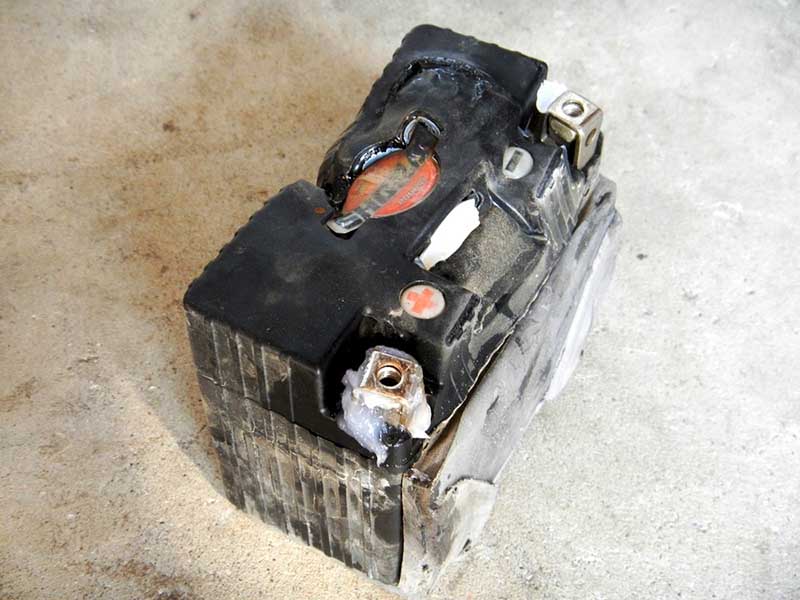【NEW】Danger - Battery Blow-Ups and Melt-Downs
|
Sure, it’s well known that, compared to lead-acid equivalents like AGM’s, lithium-ion batteries are lighter, deliver far more power, charge much, much faster, have a lot more useable capacity, will last many times longer, and are a far more savvy investment over the long run. But could they actually be as safe, or better still, safer than good ol’ lead-acid versions? Let’s first look at how unsafe lead-acid batteries can become when abused, charged from faulty or incorrectly set equipment, and manufacturers’ guidelines are ignored. Flooded lead-acid batteries can and do explode:The fact that these types of batteries have lead plates dangling in a bath of acid that’s sloshing around is bad enough, but with them being free to vent explosive and corrosive gasses to their surroundings, it is inviting disaster should things get out of whack. Case in point: A motor-home parked in a driveway had a battery explode, blowing the door of the battery compartment off and leaving little more than the base of the battery left in the compartment. It turned out that the motor-home had been parked for many months and had a small solar panel on the roof hooked up to the battery to keep it topped up. Unbeknown to the owner, the solar controller was set to condition the battery every 30 days with an elevated charge voltage to help prevent sulfation. That would have resulted in some gas being released at every conditioning charge. Without being topped-up with water occasionally, the battery would eventually have dried out. The most likely scenario is that once the battery was almost dry, the lead plates heated and buckled, so making contact and causing a spark. The liquid electrolyte that normally occupied the space inside the battery would have been replaced by an explosive gas mixture, so add a spark and … Kerblammo! AGM batteries can and do go into thermal runaway at relatively low temperatures:Absorbed Glass Mat (AGM) batteries are in the category known as Valve Regulated Lead Acid (VRLA) that also includes GEL batteries. AGM’s are still lead-acid batteries, but the liquid electrolyte is soaked into fiberglass matting squeezed in between the lead plates, and the top is sealed and fitted with pressure valves that are designed to open and release gas if the internal pressure reaches a dangerous level. In a flooded battery, oxygen and hydrogen given off by the positive and negative plates during charging are free to escape (bubble off). In contrast, the oxygen given off by the positive plate in an AGM battery must be re-absorbed by the negative plate, working its way through the fiberglass matting in the process. This oxygen re-absorption process produces lead sulfate on the negative plate during charging, and it is an exothermic reaction, meaning that it produces heat. That heat, added to the heat naturally produced by the internal resistance of the battery during charging, needs to be dissipated through the case of the battery and to the surrounding atmosphere. Now, if the battery is in an exceptionally hot environment, and/or if it is squeezed in between other batteries with no room to breathe, this can be a recipe for disaster. The crucial fact to consider here is that the warmer these batteries become, the higher the charge current they can accept. And the higher the charge current, the warmer/hotter the battery gets. So up and up goes the charge current, and up and up goes the temperature, and so on. If the battery case cannot dissipate the heat at the same or greater rate than it is being generated, the heat and internal pressure will build until the valves open. When that happens, the vents will be releasing some of the same potentially explosive gas emitted by the flooded battery. Once enough gas has vented that the matting starts to dry, it becomes easier for the heat-generating exothermic oxygen-absorbing reaction to take place, further elevating the temperature and allowing for even higher charge currents. At this point, thermal runaway is well and truly under way.. We see the results of thermal runaway in AGM batteries in the form of molten and misshapen battery cases. Although this phenomenon is indeed possible in AGM batteries on float charge, we typically see evidence of it in batteries that had been deeply discharged and then left to sit for extended periods before being charged unchecked from a powerful charger. In these situations, without careful charging and monitoring, and without adequate ventilation, things can go south quickly. A plastic battery case will typically start to soften at around 200F, and actually melt above 300F. Those are not really extreme temperatures, and when melting/softening occurs in batteries that are crammed into a tightly constrained battery box, cutting them out has often proved to be the only practical method of removal. Not a job for the average boat owner. As you can see from the above, given the right set of circumstances, lead-acid batteries can become decidedly dangerous. That’s especially so considering that they have no built-in safety mechanisms or protection to mitigate the effects of human error, faulty installation, abusive treatment, and charging equipment malfunction. |














